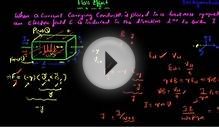- Note that there is NO eating or drinking in the 111-Lab anywhere, except in rooms 282 & 286 LeConte on the bench with the BLUE stripe around it. Thank You the Staff.
In general the Hall effect refers to the fact that a voltage can develop in a direction transverse to the current flow in a system of charged particles in a magnetic field, owing to the Lorentz force q(v x B).
The electrical resistance of conductors and non-conductors is relatively easy to describe conceptually and mathematically, and experiments illustrating these properties are easy to do. We are all familiar with Ohm's law, and with using dielectrics as insulators. The temperature dependence is nothing unusual. Semiconductors fall in between these two extremes, and their properties require some knowledge of condensed matter physics. The Hall effect illustrates the Lorentz force v X B. In this experiment you will measure the resistivity and the Hall coefficient as functions of the temperature, for an Al-doped germanium crystal. You will then determine the concentration of the free carrier. When a current is passed through a sample in the x-diredction the Lorentz force acting on the electric charges moving in a magnetic field B ( in Z) displaces some carriers in the y-direction. This causes an internal electric field H which cancels the Lorentz force in the equilibrium case. You will use the Van der Pauw method of measuring a sample of arbitary shape using the computer running LabView to acquire these data. The temperature range of this experiment is 300K to 77K to 400K.
RELATED VIDEO

